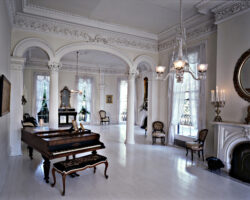Robert S. Brantley
Robert S. Brantley's photography is informed by a study of architectural history and a background in journalism.

Courtesy of Robert Brantley
Nottoway White Ballroom. Brantley, Robert (Photographer)
Born in Raleigh, North Carolina, in 1948, Robert S. Brantley principally practices his photography in New Orleans, a city he has called home since February 1977. Brantley’s architectural photography is informed by a study of architectural history and a background in journalism, the field in which he earned his degree from the University of Georgia in 1970. For twenty-five years he has trained his camera on architectural subjects both unquestionably modern and decidedly antique. Brantley’s career as an abstractor (researching the titles of lands and the structures that sit on them) invests his photographic work with a distinct reference to the historical practice of architecture. His work in that field often included reconciling the history of dozens of tracts of land—along the Mississippi River and public highways, for example—as part of the work necessary to consolidate them into a single parcel for development or expansion of existing structures.
Brantley’s early interest in photography was manifested in a supervisory role. Between 1979 and 1983 he directed the survey of historic cemeteries in New Orleans for a joint project of The Historic New Orleans Collection (THNOC) and Save Our Cemeteries (SOC). Other work undertaken in this period included cataloguing the Charles L. Franck Photographic Collection for THNOC and systematically researching drawings and building contracts in the New Orleans Notarial Archives. In 1981, Brantley photographed the facades of the first ten blocks of Canal Street (from the Mississippi River to Rampart Street), replicating a series of photographs by Charles Franck from the 1920s and a set of drawings of those blocks made by artist Marie Adrien Persac in the early 1870s. The three sets of images were included in THNOC’s exhibition The Changing Face of Canal Street. During this time he also began studying and photographing the buildings of a nineteenth-century New Orleans architect, Henry Howard, and compiling this research for publication, planned for 2014.
In 1987, Brantley combined his interests in architectural history, land usage, and architecture by establishing an architectural photography firm—Brantley & Brantley—with his spouse, Jan White Brantley (19512008). The Brantleys specialized in photographs of historic architecture using large-format cameras, including panoramic photographs made with the Cirkut™ camera. On three occasions, Brantley served as a judge for the annual SOC exhibition, Cemeteryscape.
Photographs by Robert Brantley and Brantley & Brantley have appeared in dozens of monographs, magazines, and exhibitions since 1981, including Southern Comfort: The Garden District of New Orleans (1989/1998), Capturing Oak Alley (2002), and Buildings of Louisiana (2003). Titles in preparation include a photographic study about architect Henry Howard and a monograph on the Lombard House in New Orleans’s Bywater neighborhood. Exhibitions with Brantley’s photographs have included City Park Seasons (1991, New Orleans Museum of Art) The Grand American Avenue (1994–95, traveling exhibition organized by the Octagon House in Washington, D.C.); and New Orleans Seen (2000–01, New Orleans Preservation Resource Center).
